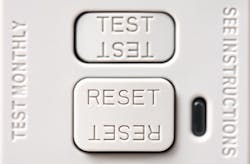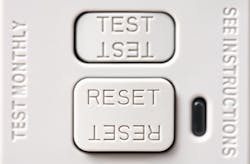Thank you for visiting one of our most popular classic articles. If you’d like to see updated information on this topic, please check out this recently published article, Recent Rule Changes for GFCI Protection. |
Note: This article is based on the 1999 NEC.
Since 1971, the NEC has expanded the requirements for ground-fault circuit interrupters (GFCI) to protect anyone who plugs into an electrical system. Initially, it was only required for temporary wiring at construction sites and in dwelling unit bathrooms, but in recent years the Code requirements for GFCI protection have expanded to include many other areas, including commercial occupancies, fountains and swimming pools, and temporary installations, to name a few. (For a complete list of 2002 NEC references, see the Sidebar at the end of this article.)
Commercial Occupancies
Per 210.8, you must install GFCI protection for all 15A and 20A, 125V receptacles located in bathrooms, rooftops, and kitchens in commercial/industrial facilities. However, GFCI protection is not required for receptacles installed outside a commercial or industrial occupancy.
In addition, 210.63 requires you to install a 15A or 20A, 125V receptacle outlet within 25 ft of heating, air conditioning, and refrigeration equipment. The only exception to this rule is that you need not install GFCI protection for fixed electric snow melting or de-icing equipment receptacles that are not readily accessible and are supplied by a dedicated branch circuit in accordance with 426.28.
Every receptacle installed in kitchens must be GFCI-protected. This new rule sets up an interesting situation. Sec. 210.8(A)(6) for dwelling units only requires GFCI protection for 15A and 20A, 125V receptacles installed to serve dwelling unit kitchen counter surfaces. However, 210.8(B)(3) requires all 15A and 20A, 125V receptacles in a commercial kitchen to be GFCI-protected.
Dwelling Units
As noted above, GFCI protection has been required for all 15A and 20A, 125V receptacles in the bathroom area of a dwelling unit for more than 20 yr.
GFCI protection devices are also required for all 15A and 20A, 125V receptacles located in garages and grade-level portions of unfinished or finished accessory buildings used for storage or work areas of a dwelling unit [210.8(A)(2)]. However, there are a couple of exceptions to this rule. GFCI protection is not required for receptacles that are not readily accessible, such as a ceiling-mounted receptacle for a garage door opener. Nor are they required for a receptacle on a dedicated branch circuit located and identified for a cord-and-plug-connected appliance, such as a refrigerator or freezer.
What about those receptacles located outdoors? Per 210.8(A)(3), all 15A and 20A, 125V receptacles outside of a dwelling unit, including receptacles installed under the eaves of roofs, shall be GFCI-protected. The only exception to this rule is that GFCI protection is not required for fixed electric snow melting or de-icing equipment receptacles that are not readily accessible and are supplied by a dedicated branch circuit in accordance with 426.28.
What about crawl spaces and unfinished areas of the basement? Once again, all 15A and 20A, 125V receptacles installed within a dwelling unit crawl space [210.8(4)] or in each unfinished portion of a basement not intended as a habitable room but used for storage or as a work area [210.8(5)], must be GFCI-protected. However, the Code does note a few exceptions to these rules: GFCI protection is not required for receptacles that are not readily accessible or are located on a dedicated branch circuit and identified for a specific cord-and-plug-connected appliance, such as a sump pump.
Don't forget kitchen or wet bar areas. Per 210.8(A)(6), GFCI protection is required for all 15A and 20A, 125V receptacles that serve kitchen countertop surfaces in a dwelling unit. GFCI protection is not required for receptacles serving appliances like dishwashers, or convenience receptacles that do not supply countertop surfaces. Receptacles installed within 6 ft of the outside edge of a wet bar sink must also be GFCI-protected [210.8(A)(7)]. However, GFCI protection is not required for receptacles not intended to serve wet bar countertop surfaces, such as refrigerators, ice makers, water heaters, or convenience receptacles that do not supply counter-top surfaces.
Receptacle Replacement
What happens when you're working at a previously unprotected location that now requires GFCI protection? It's no longer acceptable to replace an old, unprotected receptacle with a new, unprotected receptacle. Per 406.3(D)(2), you now must install a GFCI-protected device.
What if you come across a non-grounding type receptacle or an old 2-wire NM cable without a ground? These receptacles can be replaced with one of the following:
-
Another non-grounding type receptacle.
-
A GFCI-receptacle, if marked “No Equipment Ground.”
-
A grounding type receptacle, if GFCI protected and marked “GFCI Protected” and “No Equipment Ground.”
The equipment-grounding conductor plays no part in the operation of a GFCI, so it will provide ground-fault protection even on a 2-wire circuit without an equipment-grounding conductor.
Permanent Swimming Pools
The Code also requires GFCI protection for luminaries, lighting outlets, circulation and sanitation system equipment, and pump motor receptacles located near swimming pools. Per 680.22(A)(5), all 125V receptacles located within 6 m (20 ft) of the walls of a pool or fountain must be protected by a GFCI. In addition, receptacles that supply pool pump motors and that are rated 15A or 20A, 120V through 240V, single-phase, must have GFCI protection. And you must install a GFCI in the branch circuit supplying luminaries operating at more than 15V. If the pool is equipped with an electrically operated pool cover, this too must be GFCI-protected.
Temporary Installations
In accordance with 527.6(A) and (B), you should always install GFCI devices on temporary wiring systems to protect workers during construction, remodeling, maintenance, repair, or demolition of buildings, structures, equipment or similar activities. All 15A, 20A, and 30A, 125V receptacle outlets that are not a part of the permanent wiring of the building or structure shall be equipped with GFCI protection. If a 15A, 20A, or 30A, 125V receptacle is part of the permanent wiring of the building or structure and it is used for temporary electric power, GFCI protection for workers must be provided.
There is an exception to this rule. In industrial establishments where conditions of maintenance and supervision ensure that only qualified personnel are involved, an assured equipment grounding conductor program as specified in 527.6(B)(2) is permitted for only those receptacle outlets used to supply equipment that would create a greater hazard if power was interrupted or those that have a design that is not compatible with GFCI protection.
Conclusion
Creating safe installations for the public is an important job for any electrical worker. And to that end, the expanding requirements in the 2002 NEC for GFCI-type receptacles go a long way to protect the public and construction workers alike.
Sidebar: 2002 NEC GFCI References
The 2002 NEC now includes GFCI requirements for the following installations:
-
Agricultural Buildings [547.5(G)]
-
Carnivals, Circuses, and Fairs [525.23]
-
Commercial Garages [511.12]
-
Dwelling Units [210.8(A)]
-
Electric Space Heating Cables [424.44(G)]
-
Elevators and Escalators [620.23 and 620.85]
-
Fountains [680.51(A), 680.56(A), and 680.57]
-
Healthcare Facilities [517.20(A)]
-
Hydromassage Bathtubs [680.71]
-
Marinas and Boatyards [555.19]
-
Receptacle Replacement [406.3(D)(2) and (3)]
-
Spas and Hot Tubs [680.43 and 680.44]
-
Swimming Pools, Permanent [680.22(A), 680.23 and 680.27]
-
Swimming Pools, Storable [680.32]
-
Temporary Installations [527.6]
-
Therapeutic Tubs [680.62]
For more information, read "Recent Rule Changes for GFCI Protection."
About the Author

Mike Holt
Mike Holt is the owner of Mike Holt Enterprises (www.MikeHolt.com), one of the largest electrical publishers in the United States. He earned a master's degree in the Business Administration Program (MBA) from the University of Miami. He earned his reputation as a National Electrical Code (NEC) expert by working his way up through the electrical trade. Formally a construction editor for two different trade publications, Mike started his career as an apprentice electrician and eventually became a master electrician, an electrical inspector, a contractor, and an educator. Mike has taught more than 1,000 classes on 30 different electrical-related subjects — ranging from alarm installations to exam preparation and voltage drop calculations. He continues to produce seminars, videos, books, and online training for the trade as well as contribute monthly Code content to EC&M magazine.


